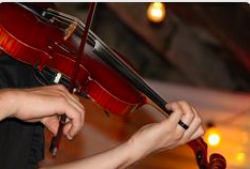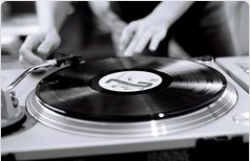Please place all of your electronic devices in this box. All of your phones, your computers, your game consoles -- they all go in the box. Now, I'm going to place this full box into this cannon . . . and fire them to the moon. Why did I do that? So you can learn how they work without getting distracted by their bright lights and colors. No texting under the table! In order to see how great our new music players are, we will go back to see how old music players work.
Music is information that sounds really good. Back in the day, people figured out a way to get sounds they like on to something that they could listen to wherever they wanted to. Let's see here . . . Ah! This . . . is a record. I know it only looks like nothing more than a big flat black circle, but like the things we just shot to the moon, it holds information on it. This is one of the first ways that people first used to listen to recorded music. This record only holds about twelve songs, hundreds less than than the phones of today. Already bored? Well, I'm glad I shot your phone to the moon then. Now you have to pay attention.
So how do we get the information out of this record? Look closely at the grooves in the black circle. That's where all of the information is kept. Before we know how to get it out, we need to know something about sound. Sound is information that flies through the air. We cannot see sound, but we can feel it with our ears. A
wave is a disturbance that travels from one place to another. Something will hit air molecules, and they will hit more air molecules and will continue to bounce off of each other all the way to your ear. This is how you hear a hammer . . . or violin music. Of course, if waves moved through the air just worked like waves through the sea, then all sounds would sound the same. Just wshh wshh. Something else is happening with sound.

Maybe it will sound better if I stand really, really close.
I'm sure you've felt a speaker that was letting out music before. It hums a bit, right? You can
feel the music. Go ahead and put your hand on your throat and speak. Again! You can
feel it! A
vibration is when something shakes or moves back and forth very fast. Sound is nothing more than a vibration that moves in waves through the air or something liquid or solid. Something will send a wave through the air, and the wave vibrates the air molecules back and forth. The air moves back and forth at different speeds and some of the waves move the air greater distances than others, which gives them different sounds. Keep your hand on your throat and make high sounds and then low sounds. Notice any differences? The record has very small bumps on it that a needle moves through. The needle vibrates as it moves through the bumps and this makes sounds you can hear!

And now give me a low note.
Now we look more closely at the record, we see that this black circle has many grooves that go in circles. It kind of looks like the rings of a tree stump. A record player has a little arm that holds a needle. The needle goes inside one of the grooves on this record and it will vibrate while it moves through the bumps in the grooves, just as your voice vibrates the air. It goes around in smaller and smaller circles from the start to the end of the record. It works pretty well to store sounds, but records are big and we can fit A LOT more music on our phones and computers that we use now.

I think this record sounds really groovy.
I will just put this needle on the record and start it turning. For a few seconds we hear the music . . . then you hear a scratch . . .
skrch pop sttic . . . That does not sound like music. It sounds like someone is hissing and throwing sand. A
distortion is a change in the shape of a wave. This will happen to records and can be from scratches to little pieces of dirt stuck in the grooves of the record. It can also happen as they get old and start to break down. If your phone had anything like that, it would break or lose your music. Imagine if every time you dropped your phone, you scratched 5 songs. They would never play the same again. If you tried to save an essay you wrote for a class this way, one scratch would make some of the letters or words wrong. It's hard enough to understand weird texts from your friends and your friends' writing already. This would make things really bad.
Oh, there we go! Even under the distortion we can hear some music. Nice, right? Analog is when something uses waves to store information or send signals. This is how records, tapes and many of the older things that we used to use to listen to music and store information worked. It's all about saving information as waves. It takes up much more space, but sure, you might get a little distortion with some dirt or scratches, but just listen to how much better it sounds than the music on your phone. You cannot hear a difference? That's fine. Your ear is young and untrained. Trust me, you will learn to like it . . . even the distortion. I mean, you have to. Your phone is on the moon now. Analog is a way of storing information by using waves and vibration. Because of how it's stored, it can get dirty and make distortion, or sound that covers the sound you want. Music played this way may sound better to some people, but storing information this way takes up a LOT of space. What if you had to walk around with fifty records in your pocket instead of your phone? What if your computer were the size of the whole classroom? It's no wonder we found a new way to store information . . .
Next: Digital!
Reference:Woodford, Chris. "Record Players and Phonographs" Explain That Stuff, 2015. <
http://www.explainthatstuff.com/record-players.html>